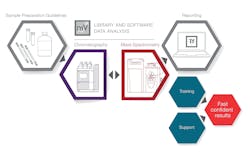Detecting new and emerging fentanyls with confidence using LC-MS
The opioid crisis is a public health emergency in the United States and an emerging problem in other countries. In 2019, nearly 50,000 people in the United States died from opioid-involved overdoses.1 To keep ahead of the manufacturing and trafficking of illicit substances, drug enforcement agencies rely on insights from forensic laboratories to track the rise of new forms of opioids in circulation. Yet emerging synthetic opioids, such as fentanyl and fentanyl analogs, are challenging to detect with conventional drug detection assays. To meet the changing demands of forensic drug analysis, new mass spectrometry (MS)-based methods that allow more sensitive, accurate and efficient detection of opioid analogs are coming to the forefront.
The challenge of analyzing fentanyls
Around 73% of opioid-involved deaths are due to synthetic opioids, such as fentanyl and fentanyl analogs.2 Carfentanil, the most potent fentanyl analog detected in the U.S., is estimated to be 10,000 times more potent than morphine.3 According to the National Forensics Laboratory Information System, the number of reported fentanyl-related overdose cases increased from 945 in 2013 to 71,341 in 2017.4 More recent numbers from the Centers for Disease Control and Prevention (CDC) show that overdose deaths involving synthetic opioids, such as fentanyl and fentanyl analogs, were nearly 12 times higher in 2019 than in 2013.5
Forensic and clinical toxicology laboratories must be able to confidently identify fentanyls in clinical samples from an increasing caseload of overdoses, and rapidly provide results to health professionals and law enforcement agencies. Yet with more than 200 different fentanyl analogs in circulation and many more rapidly emerging, this presents a challenge both in terms of efficiency and accuracy.
The increased potency of fentanyl analogs relative to morphine means they are often present in the blood at much lower levels and can be below the sensitivity thresholds of conventional drug testing methods. Moreover, although forensic laboratories have established methods for known fentanyls and other opioids, the rapidly expanding list of new illicit fentanyls means standard techniques and reference reagents are not fit-for-purpose. The chemical similarity between different fentanyl analogs also pushes the capabilities of current forensic analytical chemistry tools to the limit in terms of their sensitivity and specificity.
Current analytical methods for fentanyls
Most forensic laboratories perform immunoassays to detect specific drugs. But these assays are limited by the specificities of the antibodies used and the availability of antibodies that are validated against different opioid analogs. As new drugs emerge, antibodies are not readily available to detect them, and developing and validating new antibodies for immunoassays can take up to 12 months. By this time, new opioid analogs may well be in circulation.
Most conventional immunoassays are relatively low throughput, involving multiple wash steps and only suitable for detecting a few analytes simultaneously. More advanced analytical methods, such as liquid chromatography (LC) coupled with high-resolution accurate mass (HRAM) MS (e.g., Orbitrap mass spectrometry), enable parallel analysis through their multichannel liquid chromatography capability. These alternative approaches are quickly becoming the new gold-standard method in many forensic laboratories.
However, there is still a challenge. LC-MS techniques require libraries of standards against which fentanyls can be correctly identified. But there are so many new analogs emerging with no existing standards that it is difficult for laboratory analysts to feel confident they understand the limits of detection for these new compounds, and that they have accurately and comprehensively detected every isomer in a sample.
More sensitive analytical solutions
To help forensic laboratories confirm the presence of new fentanyl analogs, the Centers for Disease Control and Prevention (CDC) released a Fentanyl Analog Screening Kit (FAS kit) and four Emergent Panels (FAS V1-4) in 2019 in response to the rapid emergence of further analogs. In total, these reference materials support the screening for 250 opioids, including over 210 fentanyl analogs.
To demonstrate the potential of LC-MS methods for identifying closely related synthetic opioids, reference panels were used to develop optimized workflows based on Orbitrap mass spectrometry for detecting new and emerging fentanyl analogs. By creating an MS spectral library using the 213 fentanyl analogs, it tested the potential of HRAM MS for its ability to detect closely related fentanyls from biological samples. It was found that HRAM MS can identify fentanyls in urine with high sensitivity. The limit of detection for a majority of the compounds tested was 0.5 ng/mL and ≥75% of the fentanyl standards had a limit of detection of 1.0 ng/mL or better in a synthetic biological matrix, surine.6
One key advantage of LC-MS over immunoassays is that LC-MS is more specific and can identify individual compounds within a compound class. The addition of LC to high-resolution MS means fentanyl isomers with identical mass spectra can still be differentiated because they are well separated by LC. Similarly, because some fentanyl isomers co-elute chromatographically, but have different MS2 spectra and unique product ions from other isomers, these can accurately be distinguished from each other. Although there are some scenarios where analogs have similar retention times and spectra, and cannot be distinguished, these high-resolution MS protocols and the spectral library make it possible to narrow down the analytes to one of two isomers.
More efficient workflows
A further advantage of using high-resolution MS for fentanyl analysis is the potential for more efficient analysis to help meet the demands of increasing caseloads in forensic laboratories. Although it might seem that optimizing samples for analysis in an LC-MS workflow might require more time-consuming and laborious sample preparation steps than traditional immunoassays, sample preparation with HRAM MS is surprisingly straightforward. Diluted urine samples can be directly injected into an ultra-high-performance LC system coupled with HRAM MS to screen and semi-quantify fentanyl and its analogs in a single analytical run. When you compare this to immunoassay workflows, which require a series of incubation and wash steps, the use of HRAM MS can make testing much more efficient and by reducing manual tasks, frees up analysts to perform other tasks (see Figure 1).
An alternative emerging workflow for targeted fentanyl analysis is the use of paper spray tandem MS. In this workflow, the sample is deposited as a fluid (urine) on a paper sampling substrate containing previously loaded labeled standards. This paper substrate is then dried and analyzed quantitatively with tandem MS. No other sample treatment is needed between the spotting of the sample on the paper cartridge and analysis. This method allows for rapid analysis without an LC step and offers a significantly simplified process for biological sample collection. This workflow is being tested in real-time at substance use disorder clinics and has already shown comparable quantitative results to LC-MS for identifying fentanyl analogs at low levels.7
Detecting the unknowns
Importantly, high-resolution MS has potential for untargeted analysis, which gives you information about everything in the sample, not just known compounds of interest. In an experiment to identify novel unknown fentanyl opioids, an MS2 spectra library generated for the CDC FAS panel of 213 fentanyl analogs was used to establish a set of class- and structural similarity-based rules to identify unknown fentanyls from urine samples.8
The workflow for this experiment comprised three key steps.
First, it used multiple search tools to find class-based common fragments among the reference spectra. Eight common fragments of fentanyl compounds were identified through this search. Second, it conducted a similarity search using spectral data found in reference libraries, and an internal in-house spectral library of 213 fentanyls generated using the FAS Kit v1-3 was searched for similarity patterns. In the third and final step, the workflow investigated molecular networks to identify compounds that differed by transformations, such as methylation, hydration, dealkylation and so on. These rules were used to correctly identify a set of ‘unknown’ fentanyl standards from the CDC Emergent Panels spiked into urine.
This ability to perform untargeted analysis is arguably one of the greatest advantages of high-resolution MS for fentanyl screening. Its potential for providing unbiased information on all constituents of the sample, and in turn identifying the presence of unknown fentanyl analogs, provides a rapid view on the emerging and changing illicit drug landscape. It can also allow the retrospective analysis of previous samples to see if newly identified fentanyls were present in past overdose cases.
Conclusion
Forensic laboratories face an increasing workload trying to analyze the growing number of illicit opioid analogs in circulation. The higher potencies of fentanyls and the large number of structurally similar fentanyl isomers found in illicit drugs present a unique analytical challenge that requires highly sensitive and accurate techniques that work quickly on biological samples.
HRAM MS coupled with LC can accurately distinguish between structurally similar isomers of fentanyls at low concentrations. Moreover, it is possible to develop rules from the MS spectra of existing fentanyl standards that allow the identification of unknown fentanyl analogs in urine, helping laboratory scientists obtain information on all the constituents of a sample – including retrospectively.
The advent of real-time, MS-based approaches, installed at harm-checking facilities alongside high-resolution clinical laboratory tools, will be powerful weapons in our arsenal in the war against drugs, helping to turn the tide against the rise in opioid-related overdoses and deaths.
References
- CDC WONDER, Atlanta, GA: Centers for Disease Control and Prevention. 2020. http://wonder.cdc.gov/. Updated October 29, 2021. Accessed November 30, 2021.
- Centers for Disease Control and Prevention. Synthetic Opioid Overdose Data. https://www.cdc.gov/drugoverdose/deaths/synthetic/index.html. Updated March 25, 2021. Accessed November 30, 2021.
- O’Donnell JK, Halpin J, Mattson CL, et al. Deaths involving fentanyl, fentanyl analogs, and U-47700 – 10 States, July-December 2016. MMWR Morb Mortal Wkly Rep. 2017;66(43):1197-1202. doi:10.15585/mmwr.mm6643e1.
- Wilson N, Kariisa M, Seth P, et al. Drug and Opioid-Involved Overdose Deaths – United States, 2017-2018. MMWR Morb Mortal Wkly Rep. 2020;69(11):290-297. doi:10.15585/mmwr.mm6911a4.
- Mattson CL, Tanz LJ, Quinn K, Kariisa M, Patel P, Davis NL. Trends and Geographic Patterns in Drug and Synthetic Opioid Overdose Deaths – United States, 2013–2019. MMWR Morb Mortal Wkly Rep 2021; 70:202–207.
- Samra S, Hassell K, and Van Natta, K. Screening and semi-quantitation of 212 fentanyl analog compounds by the Orbitrap Exploris 120 mass spectrometer. 2021 Technical Note 66050. Thermo Fisher Scientific. https://assets.thermofisher.com/TFS-Assets/CMD/Technical-Notes/tn-66050-lc-ms-orbitrap-exploris-fentanyl-analog-compounds-tn66050-en.pdf. Accessed November 30, 2021.
- Kennedy JH, Palaty J, Gill CG, et al. Rapid analysis of fentanyls and other novel psychoactive substances in substance use disorder patient urine using paper spray mass spectrometry. Rapid Commun Mass Spectrom. 2018;32(15):1280-1286. doi:10.1002/rcm.8164.
- Samra S. Advanced search tools for unknown discovery of novel fentanyl opioids detected by HRAM Orbitrap mass spectrometry using CDC Fentanyl Analog Screening (FAS) Kit. Poster 058 presented at: Society Forensic Toxicologists Annual Meeting September 30,2021. Thermo Fisher Scientific. https://www.thermofisher.com/uk/en/home/about-us/events/industrial/society-of-forensic-toxicologists-soft.html. Accessed November 30, 2021.
About the Author

Stephanie Samra, MS
Stephanie Samra, MS, is an Applications Manager for Clinical Research and Toxicology at Thermo Fisher Scientific.
